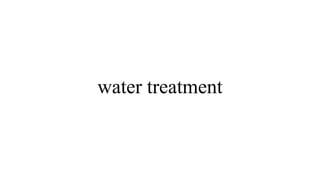
water treatment process
- 2. PROCESSED INVOLVED IN TREATING THE RAW WATER: IMPURITIES PROCESS USED FOR REMOVAL Floating matters as leaves, dead animals etc. Screening Suspended impurities as silt, clay Plain sedimentation Fine suspended matters Sedimentation with coagulation Microorganisms and colloidal matters filtration Dissolved gases, tastes and odours Aeration and chemical treatment Pathogenic bacteria Disinfection or chlorination
- 3. REQUIREMENTS OF WATER FOR DOMESTIC USE: Water for domestic use should be: • Colourless, clear, free form suspended solids. • Free form odour, and taste good. • Soft in nature. • Free form disease producing bacteria or organisms. • Free from objectionable dissolved gases, must contain a sufficient quantity of dissolved oxygen. • Free from objectionable minerals (iron, manganese, lead, arsenic and other poisonous metals). • Free form harmful salts.
- 4. WATER TREATMENT • Water can be collected from various sources like rain, surface runoff, river, lake, pond and ground water. It is not possible to find absolute pure water in nature. The primary objective of the water treatment and water purification is to, • Treat the water collected from available source. • Improving the quality of water • Removing unpleasant taste and odour • Removing of harmful matters (like bacteria etc.) from water.
- 5. IMPURITIES IN WATER ARE CLASSIFIED INTO: Physical impurities Chemical impurities Biological impurities
- 6. Suspended impurities are macro or microscopic (varies according to its origin or source) and normally remain in suspension, making the water turbid. Dissolved impurities are not visible, but cause bad taste, hardness and alkalinity. Colloidal impurities are electrically charged particles, usually very small in size that remain in constant motion and do not settle.
- 7. TYPE CONSTITUENTS EFFECT Suspended impurities Silts, bacteria, algae, protozoa Disease, odour, colour, turbidity Dissolved impurities Salts Alkalinity, hardness Metals and compounds Like (iron oxide) Taste, red colour, corrosiveness. Gases, vegetable dyes Oxygen Carbon dioxide Hydrogen sulphide Corrosiveness to metals, acidity, odour,
- 8. Typical Surface Water Treatment Plant
- 9. Chemical Coagulation-Flocculation Removes suspended particulate and colloidal substances from water, including microorganisms. Coagulation: colloidal destabilization • Typically, add alum (aluminum sulfate) or ferric chloride or sulfate to the water with rapid mixing and controlled pH conditions. • Insoluble aluminum or ferric hydroxide and aluminum. • These complexes entrap and adsorb suspended particulate and colloidal material.
- 10. COAGULATION-FLOCCULATION, CONTINUED Flocculation: • Slow mixing (flocculation) that provides for for a period of time to promote the aggregation and growth of the insoluble particles (flocs). • The particles collide, stick together abd grow larger • The resulting large floc particles are subsequently removed by gravity sedimentation (or direct filtration) • Smaller floc particles are too small to settle and are removed by filtration
- 11. GRANULAR MEDIA FILTRATION • Used to remove suspended particles (turbidity) incl. microbes. • Historically, two types of granular media filters: • Slow sand filters: uniform bed of sand; • low flow rate <0.1 GPM/ft2 • Biological process: 1-2 cm “slime” layer (schmutzdecke) • Rapid sand filters: 1, 2 or 3 layers of sand/other media >1 GPM/ft2
- 12. SLOW SAND FILTERS • Less widely used for large US municipal water supplies • Effective; widely used in Europe; small water supplies; developing countries • Filter through a 3- to 5-foot deep bed of unstratified sand • flow rate ~0.05 gallons per minute per square foot. • Biological growth develops in the upper surface of the sand is primarily responsible for particle and microbe removal. • Effective without pretreatment of the water by coagulation-flocculation • Periodically clean by removing, cleaning and replacing the upper few inches of biologically active sand
- 13. Microbial Reductions by Slow Sand Filtration • Effective in removing enteric microbes from water. • Virus removals >99% in lab models of slow sand filters. • Up to 4 log10; no infectious viruses recovered from filter effluents • Field studies: • naturally occurring enteric viruses removals • 97 to >99.8 percent; average 98% overall; • Comparable removals of E. coli bacteria. • Virus removals=99-99.9%; • high bacteria removals (UK study) • Parasite removals: Giardia lamblia cysts effectively removed • Expected removals 99%
- 14. Microbe Reductions by Rapid Granular Media Filters • Ineffective to remove enteric microbes unless preceded by chemical coagulation-flocculation. • Preceded chemical coagulation-flocculation & sedimentation • Enteric microbe removals of 90->99 % achieved. • Field (pilot) studies: rapid sand filtration preceded by iron coagulation-flocculation: virus removal <50% (poor control?).
- 15. • Giardia lamblia: removals not always high; related to turbidity removal; >99% removals reported when optimized. • Removal not high unless turbidity is reduced to 0.2 NTU. • Lowest removals shortly after filter backwashing • Microbes primarily removed in filter by entrapped floc particles. • Overall, can achieve 90% microbial removals from water when preceded by chemical coagulation-flocculation.
- 16. Thank you